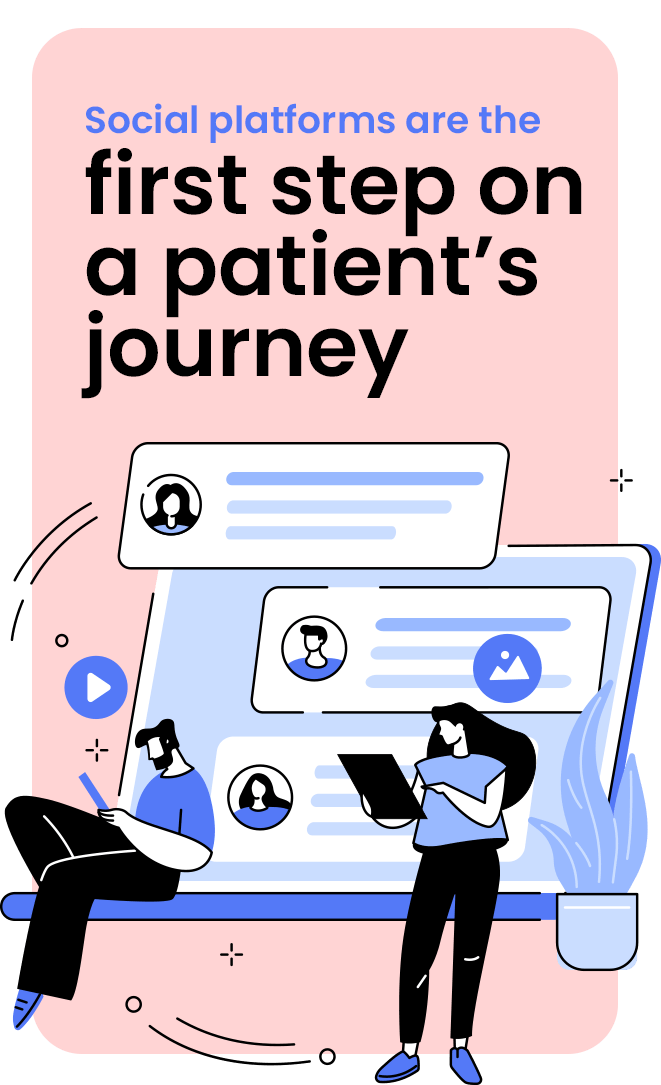Hindsight is 2020
We’ve all heard the saying, “hindsight is 2020.” And if we’d been able to predict what 2020 would hold, we would have thought we were having a bad dream. Like a terrible, unending nightmare.
Irony doesn’t even begin to cover it.
What began as a relatively calm post-holiday season back in January soon morphed into a nightmare of epic proportions. You were there, right? No one, apart from a few select centenarians (we googled it), has lived through a public health crisis of this magnitude. And because of its global impact, COVID-19 has put health care top of mind for everyone, no matter their age, ethnicity, or geographic location. One of the most fascinating things is that while these thoughts may start with health, they soon find their way into all aspects of life: financial stability, social interactions, and so much more.
Because healthcare is now ever-present in the minds of citizens around the globe, healthcare marketing should seem like a great opportunity. But how can brands effectively communicate during this complex time without seeming trite, advantageous, or just plain corrupt?
As we get more of a handle on vaccines and stopping the spread of COVID-19, some of the most critical things for healthcare brands to communicate will be: their leadership during this time; the safety of their facilities; the processes and protocols put into place to keep their patients and staff safe; and that there will hopefully be a time when the pandemic does not control all of our lives. That we will get through this together.
Please. We’re seriously losing it.
The Numbers Don't Lie

Today’s patient has become more discerning than ever. 52% of online adults in the United States prefer to buy from companies that show how they protect their customers against COVID-19 and 71% of people lose trust in a brand if the company puts profits before people. No real surprise there.
To build a healthcare marketing strategy takes data informed by consumer behavior and environmental trends. When was the last time you called your doctor on the phone to book an appointment? That’s what we thought. Today, 71% of people check online reviews of doctors and 95% of patients find online reviews to be somewhat or very trustworthy. Seems pretty reasonable that investing in a healthcare marketing strategy would be a good investment of time and treasure, especially now.
More and more patients are turning to the internet first for answers to their healthcare questions—which isn’t always the smartest move when you’re anxious about a health issue, but it’s almost automatic. And we’re not alone. In 2019, 75,000 searches each minute on Google were health-related. That’s 1 billion searches about health topics each day.
Consumers are accustomed to the convenience from other demand-driven brands like Lyft and DoorDash. It’s no surprise that everyone’s looking to obtain healthcare services in a similar fashion.
Healthcare on-demand video connects patients with healthcare providers through web sites and mobile apps. In a year marked by indefinite uncertainty, on-demand healthcare has grown into a necessary adaptation. You’ve probably seen at least one of your providers on video during the pandemic, right? Well, according to Forrester Research, the number of telehealth virtual video visits is expected to top 1 billion in 2020. Patients today expect to see their providers on video, in real time.
Healthcare organizations have to keep up with trends and outpace competitors to stay afloat in uncertain times. With multiple options and choices, many of which provide the same services, everyone needs to work that much harder to stand out from the competition.
And the lines between how organizations market themselves by channel are blurring. The beautiful thing about this trend is the ability to segment and target healthcare audiences like never before.
One of the most difficult things about healthcare marketing is that many consumers don't consider healthcare a market at all. If you need a surgery, you go to a doctor and they tell you which hospital to go to. And you pray it’s one in-network. For many patients, it isn’t clear that they are customers, or that they can, and should, ask specific questions about what would be the best fit for them and their needs. Besides making an emotional pitch, healthcare brands must share that there is in fact a choice, that it is in the patient’s best interest to evaluate all options, and then establish clear delineations between the brands.
So how do consumers choose between healthcare brands? And how can a healthcare brand make sure they’re the one chosen?
A Scientific Method
Science is a field that is ever-evolving. The same could be said for marketing. Successful healthcare brands are able to break down the science for their patients using engaging images, simple language and compassion.
In one of the most competitive industries, brands need the opportunity to enable engagement, promote content, and encourage sharing. Marketing in healthcare must engage both sides of the brain—the left side, responsible for preprocessing social emotions like happiness, and the right side responsible for processing primary emotions such as fear.

While extremely competitive, healthcare also has some of the highest brand loyalty around (which is not surprising considering it’s often your life at stake!) and organizations should lean on this powerful equity. Growing a brand takes strategy of increasing awareness, establishing presence in a new market, introducing new programs, and creating and nurturing leads. The result is a patient-centered strategy that increases customer satisfaction, supports better patient care, and lowers overall marketing costs.
Healthcare brands today must create campaigns that are responsive and encourage their audiences to act. The old model of push campaigns has evolved into two-way conversations where brands can feed prospective patients and customers exactly what they want, when they want it.
Let Me Tell You a Story
Lend us an ear. And a heart. Most healthcare stories, especially patient testimonials, are steeped in emotion. Fear, anxiety, happiness, gratitude. So in healthcare marketing, authenticity is key.
Science in itself is rational and emotionless. It alone doesn’t move markets. As human beings, we put ourselves in stories, in the situations themselves.
Brand messaging delivered as a story is up to 22 times more memorable than facts alone. One of the most difficult things about healthcare marketing is telling a story that is unique. So many brands use archaic models where if you slap a new logo on their campaign creative, you wouldn’t be able to tell the difference. It’s time to be bold in healthcare storytelling. Curating a story that is unique to an organization is fundamental to not just the survival of a brand, but to its thrival (note: we’ve petitioned Webster's to make this a word).
Whether it’s a provider sharing the first day they knew they wanted to practice, or a patient sharing their story of survival on film, stories of real people, from real people, create community.
Storytelling makes healthcare brands more human and relatable. Healthcare brand stories must:
- convey warmth and compassion,
- connect on social media,
- develop an organic presence, and
- promote sharing.
So where should brands begin?
A Picture is Worth a Thousand Words
Visual storytelling marries science with emotions and makes audiences feel connected to a brand. Creating that connection is the key to success. But how do you make a story of healthcare come to life in video?
By finding stories that stick. And telling them in inventive ways.
Viewers retain 95% of a message when they watch it in a video, compared to 10% when reading it in text. Videos add 300% more traffic to websites and 85% of consumers want to see more video content from brands. By 2021, video is expected to make up 82% of internet traffic.
Again, the numbers don't lie.
Integrating videos into healthcare marketing campaigns allows healthcare brands to rise above their competitors. Video ads can be tailored to fit the needs of the patient's journey. Creating awareness and nurturing the patient through the entire process: unaware; problem aware; solution seeking; product aware; decision making.
Video makes an impression, literally, making it the most effective means of patient engagement.
Healthcare video production used to be pretty cliché. Creating visuals that were often cold and clinical—or as they’d say in the biz, lacking of any bedside manner. Many people don't like going to the doctor or visiting hospitals, and the videos that healthcare organizations were producing weren’t doing them any favors. Speaking to topics as sensitive as patient care, destructive diagnoses, and financial disparities, producing videos for clients in the medical field is no easy task.
We’ve found there are 4 kinds of videos that make the most impact in healthcare branding:
1. Patient Testimonial Videos

We all know what it feels like to be sold to. Getting a sales pitch from a company that has no idea what you’ve gone through. You may even think, “how dare they try to put themselves in my shoes?”
For healthcare marketing, this could not be truer. Assuming we know what it feels like to have cancer when we never have, to lose a family member to heart failure when our family has never suffered loss, to get a terminal diagnosis at an early age when we are still healthy. How dare we?
The good thing is, we don’t have to. Nor should we.
Patient testimonial videos increase brand awareness without overstepping the lines of what is acceptable and honest messaging. They are a powerful way to build trust and credibility when appealing to a new market. Allowing for potential patients to hear and see the story from a peer facing the same diagnosis or treatment recommendation builds trust.
Gathering and sharing patient testimonials quickly establishes an emotional connection with your audience. Patients share narratives that are incredibly personal. Stories of remission and fight that make your heart soar, and those of loss and pain that punch you in the gut. They are trusting you with their story – and that is a huge responsibility to honor.
Patient testimonial videos create a better emotional connection for current and prospective customers. But most importantly, videos make a brand feel more human. And in healthcare, feeling human and respected is at the heart of an experience that you will remember forever.
2. Educational Videos

When you have a question about a complicated topic, where do you go for an answer? Healthcare has some of the most complex topics around and video content for healthcare must be educational to be actionable.
Video is the preferred method for education because it holds people’s attention, and it can be watched over and over again. Watching a video is much more engaging than reading a clinical white paper or lobby brochure. Educational video production presents relevant information to patients based on where they are at in their healthcare journey.
The key is to develop educational video content that is engaging, interesting and makes complex information simple without making viewers feel uneducated. Being sensitive, not sappy, explanatory, not egomaniacal.
3. Videos Built for Social

Healthcare social media video ads are highly targeted, making it a cost-effective strategy to create and nurture patient leads.
Today, more than 3.5 billion people use social media worldwide. Many of you are probably using multiple screens while you read this. Just by numbers alone, the development and distribution of social-optimized video ads is a sure-fire way to cast your net not just far, but into the right ocean.
Facebook is the #1 social media platform - and often the first step on a patient’s journey. Because Facebook allows for a highly targeted audience, such as specific demographics, custom lists and remarketing, the platform’s variety of campaigns and ad formats can fulfill marketing goals and engage hospital prospects at any stage of awareness.
By producing social video ads that are savvy and play nicely across each platform’s playground, brands can bust their way out from the pack, making for a successful medical educational campaign.
4. Optimized Video

The volume at which people are searching organically hasn’t changed. But what they’re searching for has.
From the moment a prospective patient begins to type in the search bar, a healthcare organization needs to be there. That’s the role of organic healthcare marketing.
Video content optimized for the web has been known to make a website be 53 times more likely to show up on the first page of a search. Optimized video content fundamentally boosts an organization’s website visibility. Creating optimized campaigns targets the right people in the right ways.
Sharing authentic, meaningful stories on video and through optimized social campaigns elevates a healthcare brand beyond traditional advertising. It brings something forward that’s authentic, visually beautiful and memorable.
HCP Video Advertising
Video advertising is a great way for pharmaceutical companies to connect with their target HCPs by using engaging visual content. It provides a platform to showcase products and services, explain complex topics in an easy-to-understand manner, and provide interactive tutorials. By leveraging the power of video, HCPs can access educational content quickly and get a better understanding of the product or service. Customizing video content based on specific HCPs interests and preferences can create an even more effective message. Video advertising is a memorable way for pharmaceutical companies to reach their target HCPs and promote products or services effectively. Here are some tips to keep in mind while creating video content for HCP marketing:
First, take time to understand your audience's needs and preferences to create the most effective content. Second, keep videos short and sweet since HCPs have a limited amount of time to dedicate towards marketing messages. Third, include a call to action at the end of your video to encourage HCPs to take action, such as visiting a website, signing up for an email list, or downloading additional information. Fourth, use visuals such as images and animations to supplement your message and draw attention to key points. Finally, leverage social media platforms such as YouTube, Facebook, and Instagram to share your video content and reach a larger audience of HCPs.
So, is Hindsight Really 2020?
2020 was a year none of us could have ever predicted. And honestly even if it meant we were clairvoyant, we wouldn’t have wanted to. But in the healthcare industry, we’ve seen some brands utilize human intuition, rising above the noise to share uplifting stories of frontline heroes, of achievements and patients pulling through, and of gut-wrenching tragedy as families experienced significant loss.
Stories that will stick with us forever.
So rather than look backward, let’s look forward:
To the day when businesses can reopen their doors safely and welcome back patrons who have stayed loyal through uncertain times.
To the day when our kids can return to schools as they did before surrounded by their communities.
To the day when we can safely gather together again as family and friends.
To the day when we as healthcare marketers can once again share stories that don't start with the phrase “COVID-19.”
Let’s learn from the past, the good and the bad, and create campaigns that both feel good and make an impact. Sharing stories of triumph through the worst of it all. ‘Cause things couldn’t possibly get any worse. Right?
Until then, remaining hopeful and looking forward to the day when we can say Hindsight is 2021.


